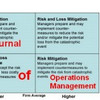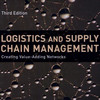 Globalization and international trade is heavily reliant on safe and open waterways. Sea transport constitutes the major part of almost every supply chain, and is thus a major contributor to risks in the supply chain. Maybe I’ve looked in the wrong places, but I haven’t seen much written on it. That is why I will make risks in the maritime supply chain the focus of this week’s posts. Here is some of what I will review…
Globalization and international trade is heavily reliant on safe and open waterways. Sea transport constitutes the major part of almost every supply chain, and is thus a major contributor to risks in the supply chain. Maybe I’ve looked in the wrong places, but I haven’t seen much written on it. That is why I will make risks in the maritime supply chain the focus of this week’s posts. Here is some of what I will review…
Three days – three posts
In the coming days I intend to present and review three items: a journal article, a conference paper and a book chapter (Links will be added as soon as the reviews are done on the date mentioned below):
2009/12/15
Barnes, P. & Oloruntoba, R. (2005) Assurance of security in maritime supply chains: Conceptual issues of vulnerability and crisis management. Journal of International Management, 11 (4), 519-540.
This paper suggests that the complex interaction of ports, maritime operations and supply chains creates vulnerabilities that requires analysis that extends beyond ISPS, CSI, and C-TPAT (for those of you familiar with these acronyms).
2009/12/16
Asbjørnslett, B.E. & Gisnaas, H. (2007). Coping with risk in maritime logistics. In: T. Aven and J.E. Vinnem (eds.) Risk, Reliability and Societal Safety. London: Taylor & Francis Group. (Proceedings of the European Safety and Reliability Conference 2007 (ESREL 2007), Stavanger, Norway, 25-27 June 2007).
Asbjørnslett has been on this blog several times before, most recently in a post on vulnerability analysis of complex industrial systems, and in this conference paper he builds on much of the same framework.
2009/12/17
Nedeß, C., Friedewald, A., Wagner, L., & Neumann, L. (2006) Risk Management in Maritime Transportation Networks. In W. Kersten and T. Blecker, (Eds.) Managing Risks in Supply Chains: How to Build Reliable Collaboration in Logistics. Berlin: Erich Schmidt Verlag.
This is a highly interesting paper, because not only does it look at maritime networks alone, but in particular does it investigate the risks associated with intermodal transports, where modes intersect, e.g. going from sea to road or sea to rail and vice versa.
Why?
As I said above, sea transport plays and important role in supply chains and supply chain risks, a role that is perhaps overlooked? Hopefully these three papers will shed some light on some of the risk issues in maritime supply chains.
Related
- husdal.com: Can pirates bring down Europe’s supply chains?












